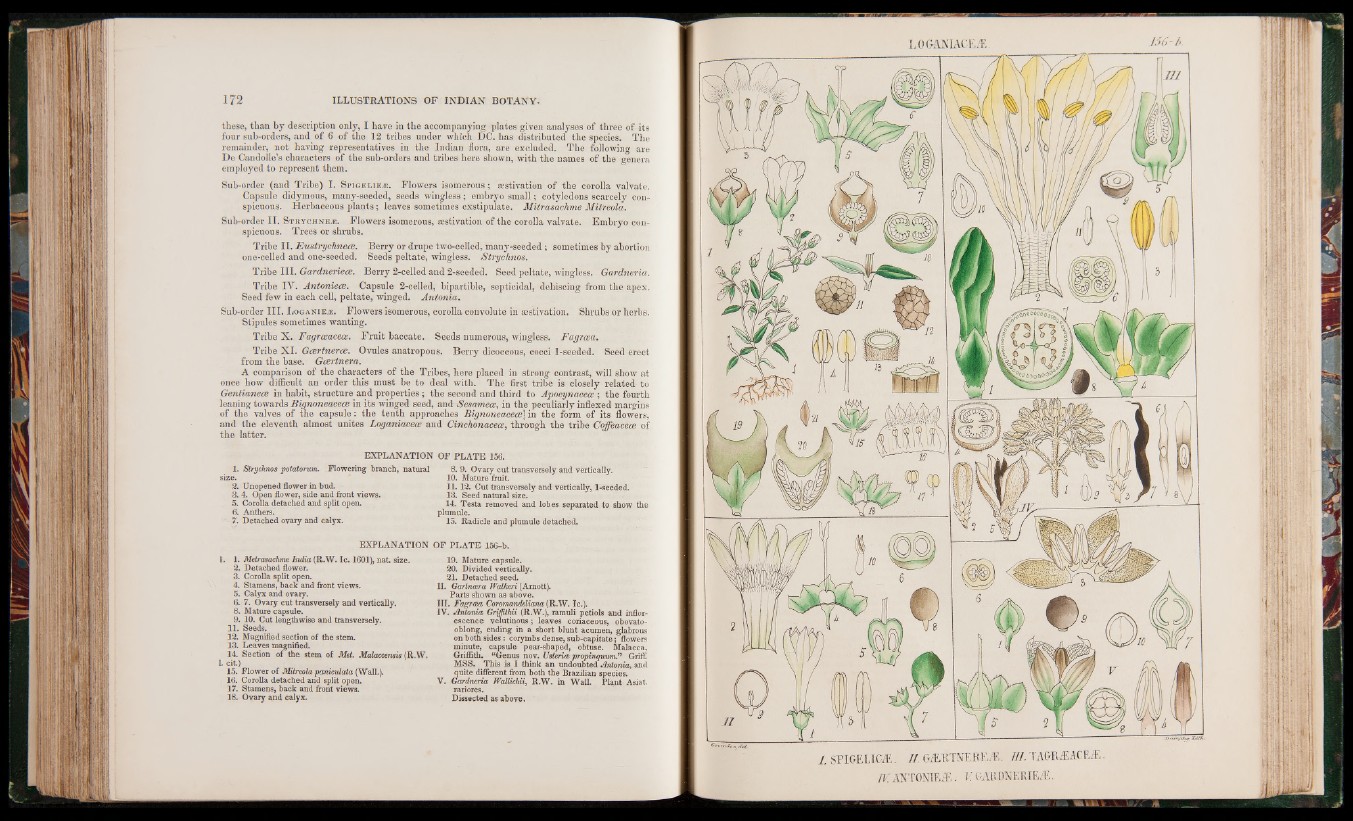
these, than by description only, I have in the accompanying plates given analyses of three of its
four sub-orders, and of 6 of the 12 tribes under which DC. has distributed the species. The
remainder, not having representatives in the Indian flora, are excluded. The following are
De Candolle’s characters of the sub-orders and tribes here shown, with the names of the genera
employed to represent them.
Sub-order (and Tribe) I. Spigelie.*. Flowers isomerous; aestivation of the corolla valvate.
Capsule didymous, many-seeded, seeds wingless; embryo small; cotyledons scarcely conspicuous.
Herbaceous plants; leaves sometimes exstipulate. Mitrasachme Mitreola.
Sub-order II. Strychne.*. Flowers isomerous, sestivation of the corolla valvate. Embryo conspicuous.
Trees or shrubs.
Tribe II. Eustrychnece. Berry or drupe two-celled, many-seeded; sometimes by abortion
one-celled and one-seeded. Seeds peltate, wingless. Strychnos.
Tribe III. Gardneriece. Berry 2-celled and 2-seeded. Seed peltate, wingless. Gardneria.
Tribe IV. Antoniece. Capsule 2-celled, bipartible, septicidal, dehiscing from the apex.
Seed few in each cell, peltate, winged. Antonia.
Sub-order III. LoganiejE. Flowers isomerous, corolla convolute in aestivation. Shrubs or herbs.
Stipules sometimes wanting.
Tribe X. Fagrceacece. Fruit baccate. Seeds numerous, wingless. Fagrcea.
Tribe XI. Gcertnerce. Ovules anatropous. Berry dicoccous, cocci 1-seeded. Seed erect
from the base. Gcertnera.
A comparison of the characters of the Tribes, here placed in strong contrast, will show at
once how difficult an order this must be to deal with. The first tribe is closely related to
Gentianece in habit, structure and properties; the second and third to Apocynacece; the fourth
leaning towards Bignoneacece in its winged seed, and Sesameos, in the peculiarly inflexed margins
of the valves of the capsule: the tenth approaches Bignoneacece\ in the form of its flowers,
and the eleventh almost unites Loganiacece and Cinchonacece, through the tribe Ccrffeacece of.
the latter.
EXPLANATION
1. Strychnos potatorum. Flowering branch, natural
size.
2. Unopened flower in bud.
3. 4. Open flower, side and front views.
5. Corolla detached and split open.
6. Anthers.
7. Detached ovary and calyx.
OF PLATE 156.
8. 9. Ovary cut transversely and vertically.
10. Mature fruit.
11.12. Cut transversely and vertically, 1-seeded.
13. Seed natural size.
14. Testa removed and lobes separated to show the
plumule.
15. Radicle and plumule detached.
EXPLANATION OF PLATE 156-b.
1. 1. Metrasachme India (R.W. Ic. 1601), n a t size.
2. Detached flower.
3. Corolla split open.
4. Stamens, back and front views.
5. Calyx and ovary.
6. 7. Ovary cut transversely and vertically.
8. Mature capsule.
9. 10. Cut lengthwise and transversely.
11. Seeds.
12. Magnified section of the stem.
13. Leaves magnified.
14. Section of the stem of Met. Malaccensis (R.W.
1. c it)
15. Flower of Mitreola paniculata (Wall.).
16. Corolla detached and split open.
17. Stamens, back and front views.
18. Ovary and calyx.
19. Mature capsule.
20. Divided vertically.
21. Detached seed.
II. G a r tn a ra Wcdkeri (Arnott).
Parts shown as above.
III. FagraM Coromandeliana (R.W. Ic.).
IV. A n to n ia Griffithii (R.W.), ramuli petiols and inflorescence
velutinous; leaves coriaceous, obovato-
oblong, ending in a short blunt acumen, glabrous
on both sides: corymbs dense, sub-capitate; flowers
minute, capsule pear-shaped, obtuse. Malacca,
Griffith. “Genus nov. Usterice p ropinquum.” Griff
MSS. This is I think an undoubted A n to n ia , and
quite different from both the Brazilian species.
V. Gardneria JVallickii, R.W. in Wall. Plant Asiat.
rariores.
Dissected as above.
L0GAWIACEÆ 156-b.
I. SPIGELICÆ. 11. GÆUTNEREÆ. 111. TA&RÆACEÆ.
IV: ANT0NIEƧ V. GAEtDNE'RIEÆ.